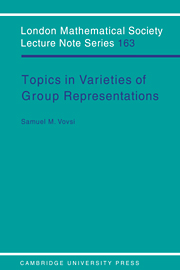Chapter 2 - LOCALLY FINITE–DIMENSIONAL VARIETIES
Published online by Cambridge University Press: 06 January 2010
Summary
One of the most interesting classes of varieties of arbitrary algebraic structures is the class of locally finite varieties. This general principle applies, in particular, in the theory of varieties of group representations. However, in the case of group representations, as opposed to more “usual” algebraic structures, it is natural to investigate two closely related notions: locally finite-dimensional varieties and, as a special case, locally finite varieties. The present chapter deals with these two classes of varieties.
Throughout the chapter the ground ring K is a field. In § 2.1 we establish a few basic properties of locally finite and locally finite-dimensional varieties. The main results of § 2.2 give a nice and somewhat unexpected characterization of such varieties in terms of stable varieties of representations and locally finite varieties of groups. This characterization is based on a result of Gringlaz [25] and Theorem 1.6.1.
Locally finite and locally finite-dimensional varieties have important numerical invariants—the so-called order functions—which are studied in §2.3. The last two sections, §§2.4 and 2.5, are devoted to critical representations. The material of these sections is more or less standard; however, it has applications specific for the context of group representations. For example, it implies that over a field of zero characteristic the lattice of subvarieties of every locally finite variety is distributive (Corollary 2.5.5).
But the major applications of the technique of critical representations will be presented in Chapter 3. In that chapter we continue to study locally finite and locally finite-dimensional varieties, keeping in mind one major theme: the finite basis problem.
- Type
- Chapter
- Information
- Topics in Varieties of Group Representations , pp. 79 - 112Publisher: Cambridge University PressPrint publication year: 1991



